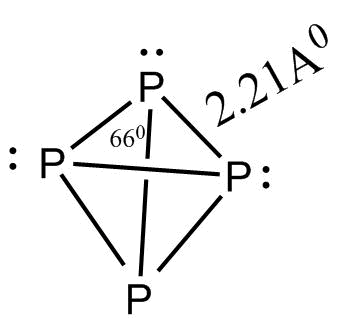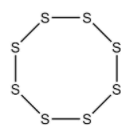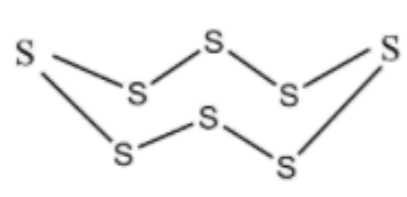
The $P - P - P$ in ${P_4}$ molecule and $S - S - S$ angle in ${S_8}$ molecule is (in degree) respectively:
(A) ${60^\circ },{107^\circ }$
(B) ${107^\circ },{60^\circ }$
(C) ${60^\circ },{108^\circ }$
(D) ${60^\circ },{40^\circ }$
Answer
551.7k+ views
Hint: Atoms in ${P_4}$ molecules are arranged in a tetrahedron structure. Whereas ${S_8}$ molecules’ atoms are arranged in a crown shape. Thus, they will have different angles between their atoms corresponding to their respective structure.
Complete step by step answer:
${P_4}$ (tetra phosphorus) is a member of tetratomic phosphorus.
A nonmetal element that has the atomic symbol P, atomic number $15$ and atomic mass $31$. It is an essential element that takes part in a broad variety of biochemical reactions.

In ${P_4}$ molecule the four $S{p^3}$ hybridized phosphorus atoms lie at the corners of a regular tetrahedron with $P - P - P$ angle ${60^\circ }$
$P_4$ has following characteristics:
-Tetrahedron shape
-P-P-P bond angle is ${60^\circ }$
-There are six bonds in total.
-Four lone pairs of electrons.
-Can form a single bond with other atoms ${S_8}$ molecules.
Cyclo octa Sulphur is a homo monocyclic compound composed of eight Sulphur atoms. It has been isolated from Ganoderma lucidum, a mushroom commonly used in Chinese medicine. It has a role as a fungal metabolic and a bacterial metabolite. It is an elemental Sulphur and a homo monocyclic compound.

Top View

Side View
In ${S_8}$ molecule, $S - S - S$ angle is ${107^\circ }$.
So, the answer is (A) ${60^\circ },{107^\circ }$.
Note: The Molecular solid is a solid consisting of discrete molecules. The cohesive forces are Van Der waal forces, dipole-dipole interaction, etc. So ${P_4}$ and ${S_8}$ are called molecular solids.
Complete step by step answer:
${P_4}$ (tetra phosphorus) is a member of tetratomic phosphorus.
A nonmetal element that has the atomic symbol P, atomic number $15$ and atomic mass $31$. It is an essential element that takes part in a broad variety of biochemical reactions.

In ${P_4}$ molecule the four $S{p^3}$ hybridized phosphorus atoms lie at the corners of a regular tetrahedron with $P - P - P$ angle ${60^\circ }$
$P_4$ has following characteristics:
-Tetrahedron shape
-P-P-P bond angle is ${60^\circ }$
-There are six bonds in total.
-Four lone pairs of electrons.
-Can form a single bond with other atoms ${S_8}$ molecules.
Cyclo octa Sulphur is a homo monocyclic compound composed of eight Sulphur atoms. It has been isolated from Ganoderma lucidum, a mushroom commonly used in Chinese medicine. It has a role as a fungal metabolic and a bacterial metabolite. It is an elemental Sulphur and a homo monocyclic compound.

Top View

Side View
In ${S_8}$ molecule, $S - S - S$ angle is ${107^\circ }$.
So, the answer is (A) ${60^\circ },{107^\circ }$.
Note: The Molecular solid is a solid consisting of discrete molecules. The cohesive forces are Van Der waal forces, dipole-dipole interaction, etc. So ${P_4}$ and ${S_8}$ are called molecular solids.
Recently Updated Pages
Master Class 12 Business Studies: Engaging Questions & Answers for Success

Master Class 12 Economics: Engaging Questions & Answers for Success

Master Class 12 English: Engaging Questions & Answers for Success

Master Class 12 Maths: Engaging Questions & Answers for Success

Master Class 12 Social Science: Engaging Questions & Answers for Success

Master Class 12 Chemistry: Engaging Questions & Answers for Success

Trending doubts
What are the major means of transport Explain each class 12 social science CBSE

Which are the Top 10 Largest Countries of the World?

Draw a labelled sketch of the human eye class 12 physics CBSE

How much time does it take to bleed after eating p class 12 biology CBSE

Explain sex determination in humans with line diag class 12 biology CBSE

Differentiate between homogeneous and heterogeneous class 12 chemistry CBSE




